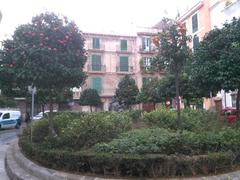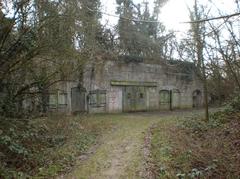Comprehensive Guide to Visiting Vesting Weesp, Abcoude, Netherlands
Date: 01/08/2024
Introduction
Nestled in the heart of the Netherlands, Vesting Weesp in Abcoude is an enchanting destination that blends rich history with modern charm. This fortified town, strategically located near Amsterdam, has been a pivotal location since the 14th century. Weesp’s historical significance is deeply rooted in its role within the Dutch Water Lines, a network of water-based defenses that safeguarded the region against invaders (Wikipedia). Over the centuries, Weesp has evolved, boasting architectural marvels from the 17th and 18th centuries, including three full-size windmills and the neoclassical former town hall, now housing the Museum Weesp (thingstodoinamsterdam).
Weesp’s contribution to the Dutch economy cannot be overlooked. It was a key supplier for the Dutch East India Company in the 17th century and the birthplace of the first Dutch porcelain factory in 1759 (iamsterdam). The town also played a crucial role in revolutionizing chocolate production, thanks to Coenraad Johannes van Houten’s innovative techniques (Wikipedia). Today, Weesp is a picturesque town offering a rich blend of historical exploration and modern amenities, making it a must-visit destination for history buffs, architecture enthusiasts, and anyone seeking a tranquil escape near Amsterdam.
Table of Contents
- Introduction
- Historical Background
- Visitor Information
- Nearby Attractions and Activities
- Preservation and Tourism
- Cultural Significance
- Modern-Day Weesp
- Visitor Tips
- Frequently Asked Questions
- Conclusion
- Sources
Historical Background
Early Beginnings and Strategic Importance
Weesp’s history dates back to the 14th century when it transitioned from an uninhabitable peat bog to a trading and defensive hub. The town received its city rights in 1355, marking its official recognition and importance (Wikipedia). Its strategic location on the river Vecht made Weesp a critical point for defense and trade during the Middle Ages.
The Role in the Dutch Water Lines
Weesp became part of the Hollandse Waterlinies (Dutch Water Lines), a series of water-based defenses designed to protect the region from invaders. The town’s fortifications were part of a larger network that could be flooded to create a water barrier against enemy forces (iamsterdam). This strategy was crucial during conflicts such as the Eighty Years’ War and the Napoleonic Wars.
Architectural and Cultural Development
The 17th and 18th centuries saw rapid growth and prosperity in Weesp. Many historical buildings, including three full-size windmills and the neoclassical former town hall, date back to this era (Wikipedia). The town hall, built between 1772 and 1776, now houses the Museum Weesp, showcasing the town’s history and its famous porcelain crafts (thingstodoinamsterdam).
Economic Contributions
Weesp is known for its production of beer, gin, and chocolate. By the 17th century, Weesp was a key supplier for the Dutch East India Company (iamsterdam). The town is also famous for its porcelain, with the first Dutch porcelain factory established here in 1759. Coenraad Johannes van Houten, a chemist from Weesp, revolutionized chocolate production by treating cocoa with alkaline salts to remove its bitter taste (Wikipedia).
Visitor Information
Weesp Visiting Hours
Most historical sites and museums in Weesp are open from 10:00 AM to 5:00 PM. However, it is advisable to check specific visiting hours on their official websites before planning your trip.
Weesp Tickets
Ticket prices vary by attraction. For example, entry to the Museum Weesp costs around €7 for adults and €3 for children. The Ossenmarkt fortress may have different pricing, so check in advance.
Travel Tips
Weesp is easily accessible from Amsterdam by train, with a journey time of about 15 minutes. Biking is also a popular way to explore the town and its surroundings. The Naardermeer nature reserve, located just 15 minutes away by bike, provides a tranquil escape into nature.
Nearby Attractions and Activities
Special Events and Guided Tours
Weesp hosts various special events throughout the year, including local festivals and guided tours. Check the town’s official tourism website for up-to-date information on events and tours.
Photographic Spots
Popular photographic spots include the historical windmills, the Ossenmarkt fortress, and the scenic river Vecht. These locations offer picturesque views perfect for capturing memories of your visit.
Preservation and Tourism
Weesp’s historical center is protected, featuring canals and numerous buildings from the 17th and 18th centuries. The town’s fortifications, part of the Defense Line of Amsterdam and the Dutch Water Line, are well-preserved and serve as popular tourist attractions (Wikipedia). Visitors can explore the Ossenmarkt fortress, which played a defensive role during the French-German war and the First World War (thingstodoinamsterdam).
Cultural Significance
Weesp’s cultural heritage is celebrated through various local products and traditions. The town is known for the Weespermop, an almond paste cookie that has become a symbol of Weesp. In 1988, local bakers set a world record by baking a 115-kilogram Weespermop, commemorated by a statue in the town center (thingstodoinamsterdam). The town also hosts the Wispe Brewery, where visitors can taste local beers and learn about Weesp’s rich brewing history (visitgooivecht).
Modern-Day Weesp
Today, Weesp is a picturesque town that offers a blend of historical exploration and modern amenities. The town’s scenic river Vecht and its surrounding roads attract yachters and cyclists. Visitors can enjoy historical buildings like the Van Houten Chocolate factory and the Museum Weesp, which continue to draw interest in its rich cultural heritage (iamsterdam).
Visitor Tips
For those planning a visit to Weesp, there are several must-see attractions and activities. The town’s historical windmills, the Ossenmarkt fortress, and the Museum Weesp are top highlights. Visitors can also enjoy a scenic boat tour on the river Vecht or rent a bike to explore the town and its surroundings (thingstodoinamsterdam). For a taste of local flavors, the Wispe Brewery and the town’s bakeries offer unique culinary experiences.
Frequently Asked Questions
What are the opening hours of Museum Weesp?
Museum Weesp is generally open from 10:00 AM to 5:00 PM. Check their official website for the most accurate information.
How to buy tickets for the Ossenmarkt fortress?
Tickets for the Ossenmarkt fortress can be purchased on-site or through their official website.
Is Weesp easily accessible from Amsterdam?
Yes, Weesp is easily accessible by train from Amsterdam, with a journey time of about 15 minutes.
Are there guided tours available in Weesp?
Yes, Weesp offers various guided tours. Check the town’s official tourism website for details on available tours and schedules.
Conclusion
Weesp’s historical background is a testament to its strategic importance, architectural beauty, and cultural richness. Its well-preserved fortifications, historical buildings, and local traditions make it a fascinating destination for tourists seeking to explore the Netherlands’ rich heritage. Plan your visit today and immerse yourself in the unique charm of Weesp.
Call to Action
To stay up-to-date with the latest information and tips on visiting Weesp, download the Audiala app, check out other related posts, and follow us on social media.
Sources
- Wikipedia. (n.d.). Weesp. Retrieved from Wikipedia
- Iamsterdam. (n.d.). Weesp: Then and Now. Retrieved from iamsterdam
- Thingstodoinamsterdam. (n.d.). Day Trip from Amsterdam to Weesp. Retrieved from thingstodoinamsterdam
- World Heritage Site. (n.d.). Dutch Water Defence Lines. Retrieved from World Heritage Site
- Travopo. (n.d.). Travel Guides: Weesp. Retrieved from Travopo
- ViaTravelers. (n.d.). Things to Do in Weesp. Retrieved from ViaTravelers
- Visit Gooivecht. (n.d.). Plan Your Visit: Weesp. Retrieved from Visit Gooivecht


